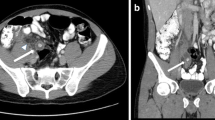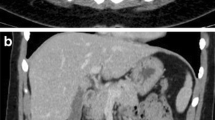Abstract
The purpose of this study was to optimize detection of the normal appendix in the clinical exclusion of acute nonperforated appendicitis using an improved and rapid method of bowel opacification in conjunction with the CT examination. A prospective evaluation of 100 consecutive patients, ranging from 13 to 50 years in age, was performed over a 4-month period using water-soluble oral contrast medium consisting of a fixed dose of diatrizoate salts administered as a prepared beverage in the emergency ward 50 min prior to performing a CT scan to evaluate clinical signs and symptoms of early acute appendicitis. The appendix was visualized in 84% (84 of 100) of patients, with a mean transit time of 50 min. The appendix filled with oral contrast medium in 89% (75 of 84) patients, and this sign was reliable in excluding appendicitis. In no instance did a contrast-filled appendix prove to represent appendicitis. The earliest signs of appendicitis were seen in 8% (8 of 100) patients. CT scan findings included absence of a contrast- or air-containing appendix with appendiceal thickening and infiltration of the periappendiceal mesenteric fat. CT scan utilizing a fixed dosage of orally administered water-soluble contrast containing diatrizoate salts, with a mean transit time of 50 min, provides a rapid and efficient means of visualizing the appendix in the clinical exclusion of appendicitis in the emergency setting.


Similar content being viewed by others
References
Scholer SJ, Pituch K, Orr DP (1996) Clinical outcomes of children with acute abdominal pain. Pediatrics 98:680–685
Rothrock SG, Pagane J (2000) Acute appendicitis in children: emergency department diagnosis and management. Ann Emerg Med 36:39–51
Rao PM, Rhea JT, Novelline RA (1998) Effect of computed tomography of the appendix on treatment of patients and use of hospital resources. N Engl J Med 338:141–146
Mullins ME, Kircher MF, Ryan DP (2001) Evaluation of suspected appendicitis in children using limited helical CT and colonic contrast material. AJR Am J Roentgenol 176:37–41
Siewert B, Raptopoulos VD, Mueller MF (1997) Impact of CT on diagnosis and management of acute abdomen in patients initially treated without surgery. AJR Am J Roentgenol 168:173–178
Oliak D, Yamini D, Uidani VM (2000) Nonoperative management of perforated appendicitis without periappendicieal mass. Am J Surg 179:177–181
Temple CL, Huchcroft SA, Temple WJ (1995) The natural history of appendicitis in adults: a prospective study. Ann Surg 221:278–281
Stroman DL, Bayouth CV, Kuhn (1999) The role of computed tomography in the diagnosis of acute appendicitis. Am J Surg 178:485–489
Balthazar EJ, Rofsky NM, Zucker R (1998) Appendicitis: the impact of computed tomography imaging on negative appendectomy and perforation rates. Gastroenterology 93:768–771
Rao PM, Rhea JT, Rattner (1999) Introduction of appendiceal CT: impact on negative appendectomy and appendiceal perforation rates. Ann Surg 229:344–349
Raptopoulos V, Katsou, Rosen MP (2003) Acute appendicitis: effect of increased use of CT on selecting patients earlier. Radiology 226:521–526
Callahan MJ, Rodriguez DP, Taylor GA (2002) CT of appendicitis in children. Radiology 224:325–332
Landis JR, Koch GC (1977) The measurement of observer agreement for categorical data. Biometrics 33:159–174
Funaki B, Grossbreutz SR, Funaki CN (1998) Using unenhanced helical CT with enteric contrast material for suspected appendicitis in patients treated at a community hospital. AJR Am J Roentgenol 171:997–1001
Kapote S, Nazareth HM, Bapat RD (1988) Barium perintonitis: a case report. J Postgrad Med 34:103–104
Thomson SR, Fraser M, Stupp C (1994) Iatrogenic and accidental colonic injuries—what to do. Dis Colon Rectum 37:496–502
Karanikas ID, Kakoulidis DD, Gouvas ZT (1997) Barium peritonitis: a rare complication of upper gastrointestinal contrast investigation. Postgrad Med J 73:297–298
Author information
Authors and Affiliations
Corresponding author
Rights and permissions
About this article
Cite this article
Giuliano, V., Giuliano, C., Pinto, F. et al. Rapid CT scan visualization of the appendix and early acute non-perforated appendicitis using an improved oral contrast method. Emergency Radiology 10, 235–237 (2004). https://doi.org/10.1007/s10140-003-0319-y
Received:
Accepted:
Published:
Issue Date:
DOI: https://doi.org/10.1007/s10140-003-0319-y




